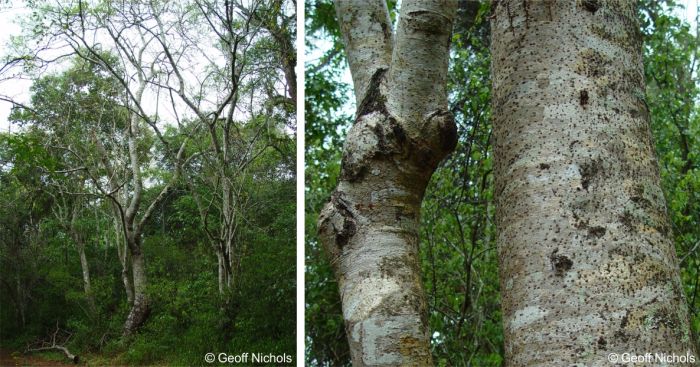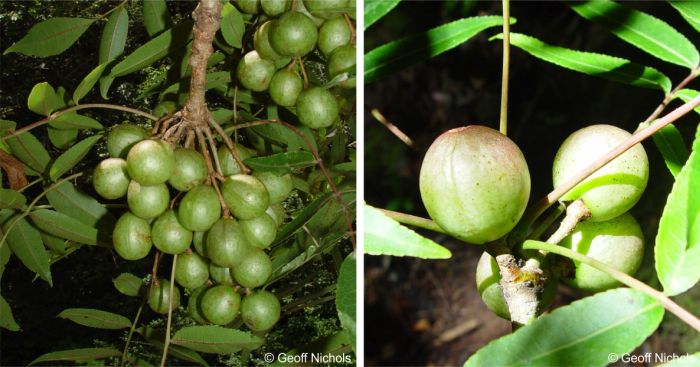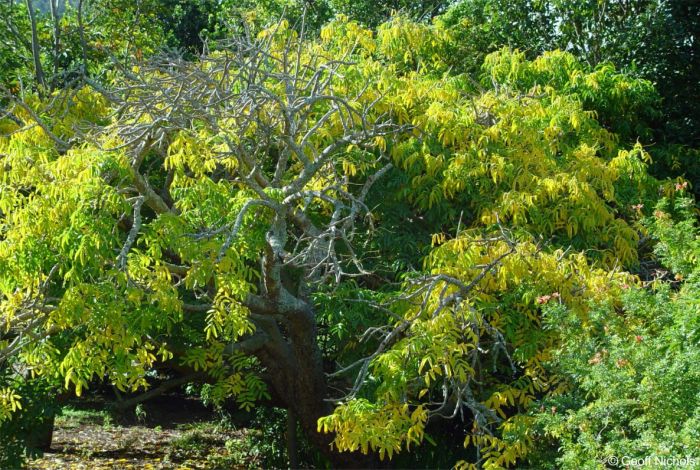Commiphora woodii
Commiphora woodii Engl.
Family: Burseraceae
Common names: forest corkwood (Eng.); boskanniedood (Afr.); iminele, wehlathi, umhlunguthi (isiXhosa); iminyela, umdewehlathi, umubu, umunde wehlathi (isiZulu)
SA Tree No: 291
Introduction
The forest corkwood is one of the few corkwoods that does not have flaking or peeling bark.

Description
Description
Commiphora woodii is a dioecious, medium-sized to large, deciduous tree that can grow up to 15 m tall. Main stem single, straight and broad, with greenish-grey bark, spotted with white, non-peeling but with occasional flaking. Branchlets are smooth, blunt, with no spikes. Young leaves are red, mature leaves are green and old leaves are yellow. Leaves are pinnately compound, in opposite pairs of 3 to 5 with a leaflet at the apex, clustered close to the ends of the branchlets. The leaflets are large, 40–100 mm long, 30–60 mm wide, smooth, oblong lanceolate, rounded at the base (wedge shaped). In warmer regions, the tree has been reported to produce leaves and flowers twice in a year and is almost evergreen.

The plant has yellowish-green flowers, in short, dense sprays up to 100 mm long, that appear along with the young, red leaves or before, flowering from late spring to early summer (October to December). The flowers are either male or female (unisexual), the flowers are of equal size (4–5 mm long); male flowers have an undeveloped gynoecium and female flowers have infertile stamens (staminodes).

The fruit is large, up to 25 mm in diameter, rounded, smooth, slightly flattened and lopsided. It is larger than the fruit of other species in the genus. The fruit resembles a cherry, turning brownish-red as it ripens. When ripe, the fruit splits open in two halves, to reveal the seed and the distinctive, red pseudaril, an extra layer that is fleshy and covers the lower third of the seed.

Conservation Status
Status
Commiphora woodii is not of conservation concern, it is assessed as Least Concern (LC) on the red list of South African plants.
Distribution and habitat
Distribution description
Commiphora woodii is found in the Forest, Thicket and Savanna Biomes, occurring on mountain slopes or in kloofs, in forest, dense valley bushveld and in thornveld, in the Eastern Cape and the coastal districts of KwaZulu-Natal, occurring almost to the border of Lesotho. The species also occurs in Mozambique.

Derivation of name and historical aspects
History
Commiphora is a combination of two Greek words, kommi, meaning ‘gum’, combined with phoros, meaning ‘bearing’, and when translated into English, means ‘gum-bearing’, referring to the aromatic, resinous gum produced by many species. This species is named in honour of John Medley Wood (1827–1915), a botanist who founded and became the first Curator of the Durban Botanic Gardens, between 1882 and 1913.
Burseraceae, the myrrh family, is a tropical plant family represented by trees and shrubs, in Africa, America and Asia. Commiphora is the largest genus in Burseraceae and is the only representative genus of the family in South Africa and Namibia. There are more than 200 species of Commiphora, that occur mainly in Africa, Arabia, Madagascar, Socotra and India, with about 26 species in southern Africa, and only 8 are found in Arabia and West India. A number of species in the genus have a peeling bark that often helps distinguish them from species in the Anacardiaceae, which is closely related. The most famous species is Commiphora myrrha, from East Africa and Arabia, which yields myrrh, a precious resin used since ancient times.

Ecology
Ecology
The fleshy red pseudaril that covers the seed is fed on by many birds, such as the Hornbills, Red-winged Starlings, Black-headed Orioles and Cape Glossy Starlings, when the fruit splits open. Parrots do not wait for the fruit to split naturally but instead open the fruit with their beaks. These birds disperse the seeds in their droppings. Pollination of the flowers is done by small insects such as bees and some beetles that visit the tree when it is in bloom. Commiphora woodii is adapted to rainfall in summer and a dry winter, with average annual rain fall of 650–1400 mm.

Uses
Use
The wood is light and is reported to have been used for fishing floats in the past. It has also been used to create fences by using the branches as truncheons. An aromatic gum can be obtained from the bark of the plant. There are no reports of Commiphora woodii being used in traditional medicine.

Growing Commiphora woodii
Grow
Commiphora woodii is a fast-growing species that can be propagated both sexually (by seed) and asexually (vegetatively).
When propagating from seed, remove the red pseudaril before sowing, use a well-drained sowing medium, keep warm and moist. Seed should germinate within about 14 days.
When propagating vegetatively, use a propagation mix of river sand and coarse-milled bark, with sterilized seed trays as your containers. Sterilize your seed trays, cutting tools and medium to avoid your cuttings being infected. Take cuttings from healthy, disease- and pest-free mother plants. Use a sharp, sterilized, cutting tool to make clean cuts. Select the cooler parts of the day to make cuttings, the plant is more resilient during this time. Put the coarse-milled bark as a base in your seed tray to improve drainage, fill up the rest of the tray with river sand. Make truncheon cuttings of around 30–60 cm long and 2–3 cm wide. Make a cut below the node at the base of the cutting, because this is the area where cells are actively dividing. Make a slanted cut above the node at the tip of the cutting to prevent standing water, which can cause die-back. Make sure to remove at least two thirds of the leaves from the lower part of the cutting, to reduce water loss through transpiration.
Insert your cutting into the river sand and then place your tray in a warm, humid, and moist area until the cuttings have rooted. When the cuttings have properly rooted, transplant them into nursery pots using a mix of 1 part river sand: 1 part sifted bark. Water your plants well and harden them off in a semi-shaded area. Apply a slow-release fertilizer that will promote further growth of your plant. The plant can be planted out into the garden when leaves and branches are well developed.
Commiphora woodii can also be propagated by truncheon cuttings planted directly into the ground, and, where branches are used as fencing poles they often root and grow.
References
- Gabayi, M. 2017. Commiphora harveyi (Engl.) Engl. (Burseraceae). PlantZAfrica. Online: http://pza.sanbi.org/commiphora-harveyi
- JSTOR Global Plants. Compilation page: Commiphora woodii. https://plants.jstor.org/compilation/commiphora.woodii (Accessed 15 September 2021).
- Moll, E., 2011. What's that tree? A starter’s guide to the trees of southern Africa. 1st ed. Cape Town: Struik Nature.
- Nichols, G. 2005. Growing rare plants: a practical handbook on propagating the threatened plants of southern Africa. Southern African Botanical Diversity Network Report No. 36.
- Coates Palgrave, K. 1977. Trees of southern Africa. Struik, Cape Town.
- Palmer, E. & Pitman, N. 1972. Trees of southern Africa. Balkema, Cape Town.
- Pooley, E. 1993. The complete field guide to trees of Natal, Zululand and Transkei. Natal Flora Publication Trust, Durban.
- Thomas, V., Moll, E. & Grant, R. 2008. SAPPI tree spotting Cape: from coast to Kalahari. Jacana Media, Johannesburg.
- Van der Walt, J.J. 1974. A preliminary report on the genus Commiphora in South West Africa. Madoqua 1(8): 5–23.
- Van der Walt, J.J.A. 1973. The South African species of Commiphora. Bothalia 11(1&2): 53–102.
- Van Wyk, B. & Van Wyk, P. 1997. Field guide to trees of southern Africa. Struik, Cape Town.
- Van Wyk, A.E., Van den Berg, E., Coates Palgrave, M. & Jordaan, M. 2011. Dictionary of names for southern African trees: scientific names of indigenous trees, shrubs and climbers with common names from 30 languages, edn 1. Briza Publications, Pretoria.
Credits
Siphesihle Precious Sibiya
Kirstenbosch National Botanical Garden
October 2021
Acknowledgements: the author thanks Mpendulo Gabayi for his assistance with her writing style and urging her to do better, and Geoff Nichols for providing the images.
Plant Attributes:
Plant Type: Tree
SA Distribution: KwaZulu-Natal
Soil type: Sandy, Loam
Flowering season: Spring, Early Summer, Late Summer
PH:
Flower colour: Green, Cream
Aspect: Full Sun, Morning Sun (Semi Shade), Afternoon Sun (Semi Shade)
Gardening skill: Easy
Special Features:
Horticultural zones









Rate this article
Article well written and informative
Rate this plant
Is this an interesting plant?
Login to add your Comment
Back to topNot registered yet? Click here to register.